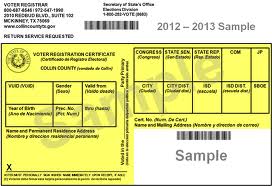It’s good to see, whatever it “means”.
Still the only voter ID anyone should need
Texas now has almost 17.7 million voters — 1.9 million more than four years ago, when Gov. Greg Abbott won re-election.
New voter registration totals from the Texas Division of Elections show the state’s voter rolls are continuing to grow even faster than the population. While the state’s population has grown about 7 percent since 2018, voter registrations have grown about 12 percent.
Nowhere has the surge been bigger than in Harris County, where 230,000 people have been added to the voter rolls since 2018. Tarrant and Bexar counties are next, with more than 130,000 more voters than four years ago. All three counties voted Democratic in the 2020 presidential election.
The result is that at least 1 of every 5 voters in Texas never cast a general election ballot in the Lone Star State prior to 2014 — a remarkable wild card in a state that had stable politics and a slow stream of new voters for a generation before that.
Some of the biggest percentage increases in voter registrations are coming from booming counties that voted Republican in 2020.
Comal County, just north of San Antonio, saw a 29 percent increase in voter registrations from four years ago — the highest growth percentage of any county in the state. Not far behind was Kaufman County, east of Dallas, which also grew by about 29 percent.
[…]
Since 2014, Texas has added 3.6 million voters — roughly equivalent to the populations of Wisconsin and Minnesota.
The increase can be traced to 2014, when a group of campaign strategists from President Barack Obama’s re-election campaign launched an effort they called Battleground Texas to build an army of volunteer registrars.
See here and here for some background, and here for historic data. It’s wild that this has accelerated so much in recent years – we’ve talked about how Harris County was basically flat for years prior to 2012. This will have to slow down, at least to equalize to the rate of population growth, but today is not that day.
The increase in voter registration is absolutely a factor in the recent surge in turnout. In 2014, with 14 million voters and 33.7% turnout, there were 4.7 million total ballots. With 17.7 million voters, 33.7% turnout would be almost 6 million votes. Needless to say, we expect a higher percentage turnout than that this year. If we get the 8.3 million voters we got in 2018, that’s 47% this year, while it was 53% in 2018. I don’t know what we’ll get and I’m not trying to make a projection, I’m just noting that we have a higher floor now.


Charles: Just for the record, the author’s claim that the 3.6 million added voters is equal to the populations of Wisconsin and Minnesota is absolute nonsense. For the 2020 Census, Wisconsin had 5.9 million and Minnesota had 5.8 million. That doesn’t change the point of the article, but such inaccuracy should not occur in an edited article.